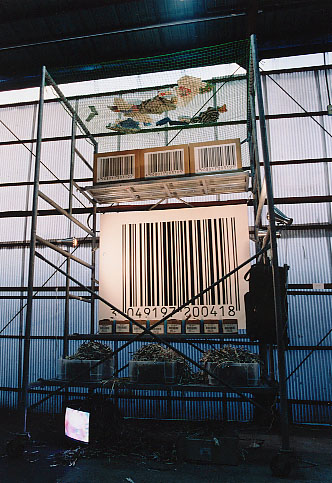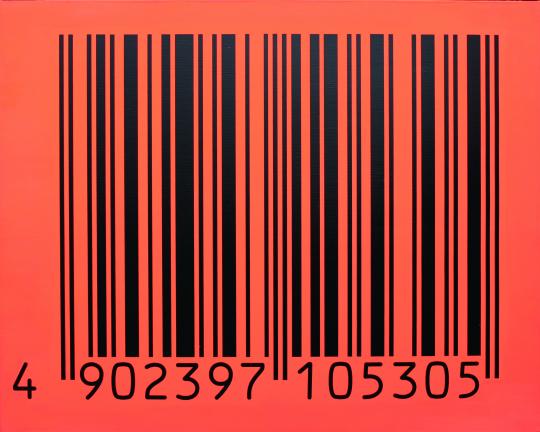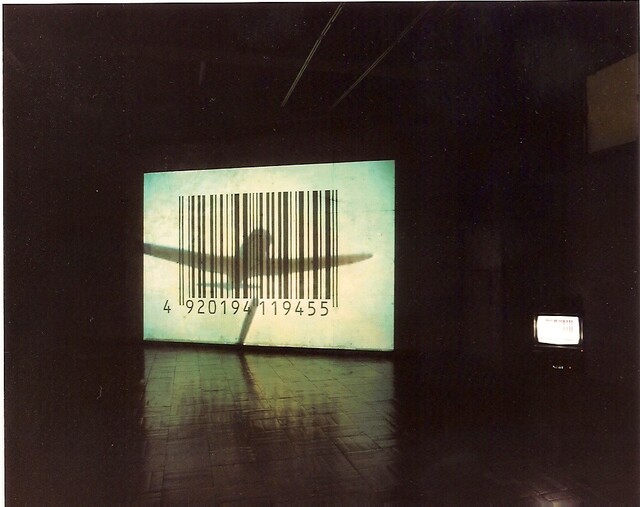Taisuke Morishita Solo Show《Barcodes》
English follows
森下泰輔 個展
Barcodes
2022年9月21日(水)~10月1日(土)
15:00~20:00 最終日も20時 26日(月)休廊
森下泰輔のバーコード
天乃英彦(美術評論家)
「ポップとキュビスムを合体させたような作品を91年まで制作していましたが、X-JAPANの肖像を作ってくれという注文を済ませると新たなテーマに取り組むつもりで、その当時、盛んに商品に付けられ始めたバーコードを主題にした作品に取り掛かりました。
このとき、人間がデジタル統計学的なAIにつながる記号に取り込まれ始めたと感じたので、20世紀最後の10年という同時代のために、これを自らのアートの主題にすることにしました。
美術史とは大きな人類史を記述とはべつの方法で自明化する作業だからです。
いまひとつは絵画の構成上の問題でした。ダダの発見した複合イメージであるコラージュはポップやキュビスムにも大きな影響を与えましが、もうひとつレディメイドは、ネオダダにおいてレディメイド・イメージという情報時代の発展を遂げました。
その意味においてバーコードは記号論的レディメイド・イメージだといおうとしましたが、実はレディメイドそのものでした」(森下泰輔)
「森下泰輔のバーコードを用いた作業はウォ―ホルよりも、むしろデュシャンを思わせる」(美術評論家・日向あき子)。
しかも有史以来初めて人類に向けられていない記号であり、ここに20世紀晩期の古典的意味合いにおいての近代的人間の時代の終焉を見たと彼は言う。
森下泰輔がバーコードを作品に使用し始めたのは1991年からだ。パリ・コンコルド広場の壁を蛍光ピンクと銀のキャンバスに転写し、中央に12個のコカ・コーラの缶をバーコードの側を向けてセットしそのまた中央にはキャンバスに描かれたバーコードを据えた。翌92年、F0号キャンバスに色とりどりのバーコード28点を組み合わせた《28BARCODES》を制作する。森下は80年代には絵画と並行してビデオアートも制作、《JANE-DOE 66》(1986)や《DEMO》(1988)の一部は国際ビデオアート展「インフェルメンタル」に選ばれドイツのメディアアート美術館ZKMに入っているが、90年代に入ってもルーブルを題材とした《ルーブル》(1993)や自ら出演したカルトQ(フジテレビ)を題材とした《カルトQ-BARCODE》(1994)などをバーコード絵画と同時進行で作っている。同作は、優勝したカルトQの「ポップアート」の回の答え部分を
すべて「バーコード」という解答に変換したものだ。
その後、銀座・ギャラリーラランヌでの個展「BARCODE490811203105」(1994)では、F30号大のキャンバスが登場している。同年、ラフォーレミュージアム飯倉で開催されたグループ展示で森下は5m×4.5mの巨大バーコード(IF Museum, Easton, Pennsylvania,USA収蔵)を天井から吊るしている。
1994年横尾忠則、今井俊満らとともの現代美術公募、CA協会の審査員も行った。
アートフェア東京以前の日本初のアートフェア、NICAFでもたびたびバーコード絵画を展示してきた。1995年からはシミュレーショ二ズムを標榜してティチアーノやアングル、ベラスケス、ダヴィンチなどの名画にバーコードを接続するシリーズを始めた。
この時期、ジェフクーンズにバーコードを付加した《ジェフクーンズ-バーコード》を制作してもいる。《1㌦=78円》では、実際の一ドルとアクリルボックスに入った78円を作品化している。バブル崩壊後の95年においても円は強かったのだ。同年の「モルフェ95」に参加、バーコードを付加した段ボール20個あまりを展示し、アンディ・ウォ―ホルのブリロボックスの消費社会概念を延長している。ウォ―ホルを参照しているものとしては、《ウォ―ホルズ・フラワー-BARCODE》(1996)、《エンパイア-BARCODE》(1996)《FLOWERS-BARCODES》(2015)などがある。
そもそも「アンディが1987年に亡くなり、90年代はアンディがモチーフにできなかったものを主題にする。バーコードもそのひとつです」(森下)と語っている通り、ポストウォ―ホルのネオジオ、シミュレーショにズムに同調しているのだ。
1996年には個展「BARCODIZM 96」(銀座・小野画廊)があり、F30大のバーコード絵画24点を展示している。97年になるとルノワールやアニメイメージにバーコードを付加する作品も多く制作、第五回NICAFでは個展形式で発表した。97年は、宇治野宗輝、松蔭浩之、笠原出、文田牧人、菅間圭子、大岩オスカールらとグループ展を銀座で開催した。
1997年はまた、日本のアニメーションのレディメイドのセル画をバーコードに絡めた作品をはじめ、建て替え前の東京大学教養学部南ホールで、バーコードと廃材を使用した21mにも及ぶ大規模インスタレーションに転じる。以降、大久保グローブ座での世界のバーコードに国旗を付加しバーコード世界地図を赤く塗りつぶした《ワールド・バーコードマップ》(1998)やフランス、ブルゴーニュでの《ラ・グランド・ジョコンダーBARCODE》インスタレーション、パリの画廊でのバーコード・ショーでは巨大モナリザにバーコードを付加するといったインスタレーションを発表。1998年ポーランドで発表した《僕らの消費社会》、《多国籍企業》(2000)市ヶ谷・法政大学、9.11のさなかに展示した《大東亜戦争ーBARCODE》(2001)、《神話》(2003)、など、90年代後半からはインスタレーションの素材としてバーコードを用いる方向に変化している。
森下がポリティカル3部作と呼ぶ、天皇制と日本美術の関係性、戦後の日米地位協定下の美術に言及した《國GHQ皇》(2003)、《Made In Occupied Japan》(2005)、《マッカーサーノート》(2006)などでも政治性批判を基幹にしたインスタレーションだ。2006年には初のニューヨーク個展をFAミュージアムで開催、ここでも「ゴキブリ- 」と題し、バーコードを絡め資本主義の運動をゴキブリ生態と絡めたインスタレーションを展開している。このように、平面としてのバーコード絵画、作品は20世紀末、90年代に集中して制作されている。
2005年以降は銀座でスタートしたギャラリー運営や90年代後期から継続している美術評論活動などと並行して、クリティカルアートとして名画にバーコードを付加するシリーズやフェミニズム運動を非西欧圏の芸術の台頭と同一概念で語る《デ・アブジェクション》(2004-2006)、《K-POP スタイル》(2015)のシリーズや、2020~2021の《バーコード・マリリン・シリーズ》で再びバーコードを展開し始めているが、ミニマルなレディメイドイメージとしてのバーコード絵画から、より複合した概念に発展しているといえよう。2019年には、ペンシルヴァニア州イーストンで、大型のバーコードを富士山に見立てたインスタレーション《Fuse the 4 parts》を行っている。
2003年にニューヨークのトライブスギャラリーで開催された「コミュニケ」に参加。その後もトライブスギャラリーとは関係を持ちグループ展にも数回出品したが、2022年のホイットニーバイアニュアルにトライブスギャラリーがいわゆる白人中心の美術に少数民族の美術を送った功績で作家として選ばれたために森下の作品が掲載されたアート本(ジン)も作品として出品された。
今回のバーコード絵画回顧は1991年から31年にもわたる森下芸術がコンパクトに俯瞰できる内容となっている。
https://artlab-tokyo.com/artists/detail.html?part=part4&id=20170721135308
Taisuke Morishita Solo Show
Barcodes
9/21(wed)~10/1(sat), 2022
15:00~20:00 closed on 26th(mon)
Barcode of Taisuke Morishita
Hidehiko Amano (art critic)
“Up until 1991, I was producing works that seemed to combine pop and cubism, but when I received an order to make a portrait of X-Japan, With the intention of tackling a new theme, I started working on a work on the theme of bar codes, which were beginning to be attached to products at that time.
At this time, I felt that humans were beginning to be incorporated into symbols leading to digital statistical AI. I decided to make this the subject of my art for the sake of my contemporaries, the last decade of the 20th century.
This is because art history is the work of clarifying the big history of mankind in a way that is different from describing it.
Another problem is the composition of the painting. Collage, a composite image discovered by Dada, had a great influence on pop and cubism,
Another readymade has developed in the information age of the readymade image in Neo-Dada. In that sense, I tried to say that the barcode is a semiotic ready-made image, but in reality it was a ready-made itself. (Taisuke Morishita)
“Taisuke Morishita’s work with barcodes is rather, it reminds me of Duchamp" (art critic Akiko Hyuga).
Moreover, for the first time in recorded history, it is a symbol that is not directed at humans, Here, he says, we see the end of the modern human age in the classical sense of the late twentieth century.
Taisuke Morishita began using barcodes in his work in 1991. The walls of Place de la Concorde in Paris are transferred onto a fluorescent pink and silver canvas, with 12 Coca-Cola cans in the center. He set the bar code side up and placed the bar code drawn on the canvas in the center. In 1992, he combined 28 colorful barcodes on the F0 canvas. Produced "28 BARCODES". In the 1980s, Morishita also produced video art in parallel with his paintings.
He was selected as "Infermental" and parmanented the media art museum ZKM in Germany.
He is making works such as Cult Q-BARCODE (1994), which is based on Cult Q (Fuji TV), at the same time as barcode painting. The work is the answer part of the winning Cult Q's "Pop Art" times. All of them have been converted to the answer "barcode".
After that, in the solo exhibition "BARCODE490811203105" (1994) at Gallery Lalanne in Ginza, a F30 size canvas appeared. In the same year, it was held at Laforet Museum Iikura In the group exhibition, Morishita hangs a huge 5m x 4.5m bar code (collected by IF Museum, Easton, Pennsylvania, USA) from the ceiling.
In 1994, he was also a juror of the Contemporary Art Contest with Tadanori Yokoo, Toshimitsu Imai, and others.
Prior to Art Fair Tokyo, he has often exhibited barcode paintings at NICAF, Japan's first art fair. Since 1995, advocating simulationism
He started a series of connecting barcodes to famous paintings by Titiano, Ingres, Velázquez, Da Vinci and others.
During this period, he also produced "Jeff Koons - Barcode", which added barcodes to Jeff Koons. In the other work "1 dollar = 78 yen" Morishita put the actual dollar and real 78 yen in small acrylic box. Even in 1995, after the bubble burst, the yen was strong. In the same year, he participated with Makoto Aida in "Morphe 95" Exhibits and extends Andy Warhol's Brillobox concept of consumer society. As a reference to Warhol, "Warhol's Flower-BARCODE" (1996), "Empire-BARCODE" (1996), "FLOWERS-BARCODES" (2015) and others.
In the first place, "Andy passed away in 1987, and in the 90's the theme was something that Andy could not use as a motif. Barcodes are one of them."
There was same element as Post-Warhol's NeoGeo, and the simulationism.
In 1996, there was a solo exhibition "BARCODIZM 96" (Ginza, Ono Gallery), displaying 24 F30-sized barcode paintings. In 1997, barcodes were added to Renoir and anime images.
Many additional works were also produced, and were presented in the form of a solo exhibition at the 5th NICAF. In 1997, he held a group exhibition in Ginza with Muneteru Ujino, Hiroyuki Matsukage, Izuru Kasahara, Makito Fumita, Keiko Kamma, and Oscar Oiwa.
In 1997, he also produced a series of ready-made cels from Japanese animation with bar codes.
It turns into a large-scale installation of 21m using waste materials at south hall of Tokyo university Komaba. Since then, "World Barcode Map" (1998), which added national flags to the world barcodes at the Okubo Globe Theater and painted the barcode world map red.
Installation "La Grande Joconda- BARCODE" in Burgundy, France, and an installation that added a barcode to the giant Mona Lisa at the Barcode Show at a gallery in Paris.
And the other installation "Our Consumer Society" was exhibited in Poland in 1998. "Multinational Corporations" (2000) Such, From the latter half of the 90's, there has been a shift towards using barcodes as a material for installations.
Morishita refers to the relationship between the imperial system and Japanese art as his political trilogy, National GHQ Emperor (2003), Made In Occupied Japan (2005), and MacArthur Note (2006)
It is an installation based on criticism of political nature. In 2006, he held his first solo exhibition in New York at the FA Museum, again titled "Gokiburi". He is developing installations that intertwine the movement of capitalism with bar codes and the ecology of cockroaches. In this way, bar code paintings and works were produced intensively in the 90s. In 21c his works turn to installation.
Since 2005, in parallel with the gallery management that started in Ginza and the art criticism activities that have continued since the late 1990s, a series of adding barcodes to masterpieces as critical art and
The series De Abjection (2004-2006) and K-POP Style (2015), which talk about the feminist movement in the same concept as the rise of non-Western art, and the 2020-2021 Barcode Marilyn in the series
Although he has begun to develop barcodes again, it can be said that he has developed from barcode paintings as minimal ready-made images to a more complex concept. Also in 2019, in Easton, Pennsylvania, he created an installation called “Fuse the 4 parts,” in which a huge bar code is likened to Mt. Fuji.
In 2003, he participated in the "Communiqué" held at the Tribes gallery in New York. He continued to have a relationship with Tribes gallery after that, and exhibited several times in group exhibitions, but in 2022 Morishita's book work was exhibited in the Whitney Biennial because the Tribes Gallery was selected as an artist for the achievement of sending minority art. Tribes gallery's editional art book (Zine) was also exhibited as a work.
This bar code painting retrospective is a compact overview of Morishita's art spanning 31 years from 1991.
https://artlab-tokyo.com/artists/detail.html?part=part4&id=20170721135308








